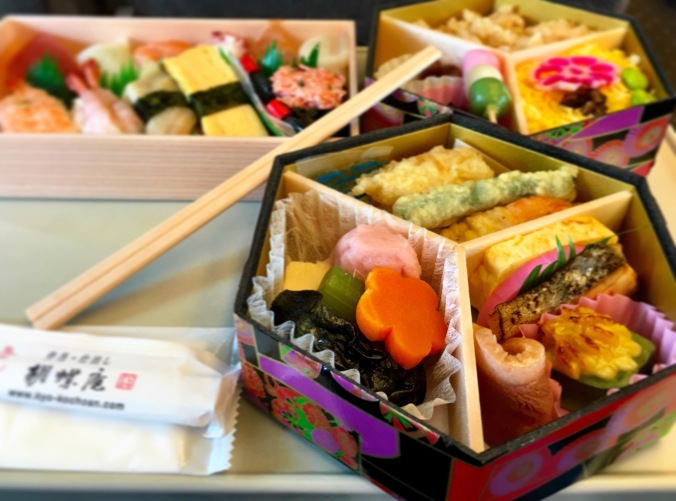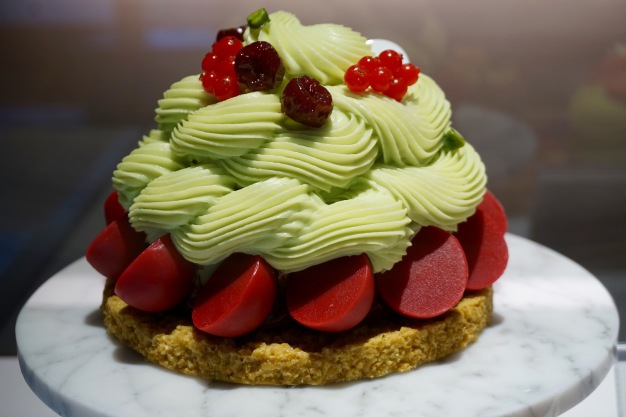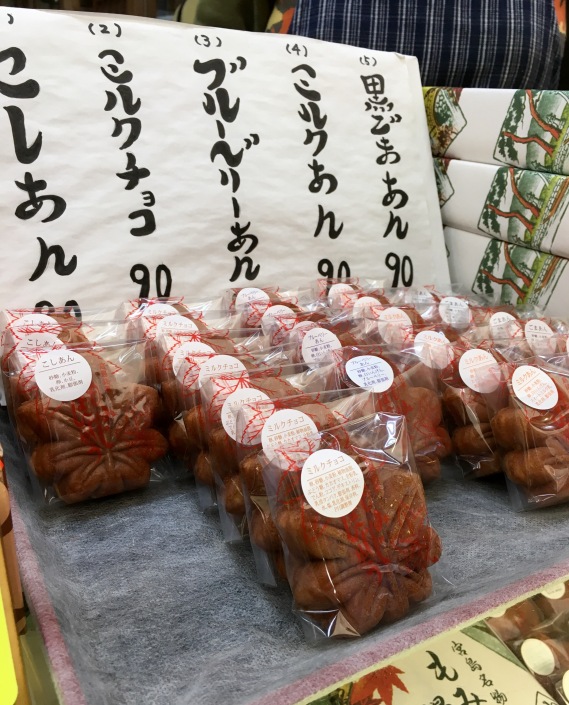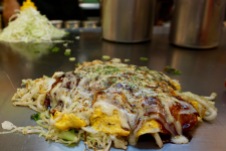
Bento boxes from Kyoto railway station
The myriad preconceptions about Japan and its culinary reputation are always consistent no matter who you hear them from:
- It’s just as difficult to secure a reservation as it is to have a bad meal.
- There’s much more to Japanese food than sushi.
- Tokyo is home to more Michelin stars than anywhere else in the world.
- Japanese chefs generally focus on one singular style of cooking before perfecting it.
- Prepare yourself for a ton of seafood – even for breakfast!

Steamed Beef buns
All true, but there is a whole lot more to it before you finally snap your hashi (chopsticks) apart. For the average westerner, the Japanese kitchen scores very highly under the following criteria:
Presentation – probably the most attractive and appetizing works of art you will ever see on a plate – from 3-star tasting dishes to pre-packaged bento boxes. It’s always absolutely, reliably, unbelievably Instagram-astic.
Ingredients – Everything you will ever eat in this country will be of the freshest and highest quality in the world. The notion of foodborne issues never crossed my mind – even if I was eating raw eggs. (See below).
The next few, however, are where things start to become a little iffy for the less-adventurous:
Location – It takes a little while to reconcile the notion of climbing down into a small, windowless, sign-less, basement box of a room to enjoy the most excessively expensive (and enjoyable) dinner you’ve ever eaten. Or that one of your more memorable meals might be found in, at – or under – a train station.
Flavor profile – Let me put this as simply as I can: it’s different. Foods that normally carry a bonfire of spice back home, tend to be oddly muted in Japan. Not that that’s bad – it’s just different. Conversely, when you prepare your palette for the subtle flavors of seafood you’re accustomed to, it could feel like you just bit into a 100-year old anchovy from the darkest recesses of the ocean. Again, not bad – just different.
Texture – while Japanese foods tend to run the gamut from “crispy to crunchy”, you’d do well to prepare yourself for “sticky to slimy” as well. (Hey, I’m just puttin’ in out there.)
Surprise – This is where we separate the men from the boys. In a world where English is rarely spoken (particularly by restaurant servers or market stall cooks), what do you do when you have neither the slightest recognition nor comprehension for what it is you are holding between your hashi? Hmmmmm.

Traditional Japanese Breakfast
All my efforts to research a multitude of websites, blogs, articles, and personal recommendations to hand pick 4 good restaurants out of the 82,000 that Tokyo offers, were largely a waste of time. Those that were truly top of my list were either not bookable by foreigners, required multiple pre-departure phone calls well after midnight, were booked out more than 4 months in advance, or I am still waiting to hear back from them. And so I was left with my 2nd, 3rd and in some instances 4th tier choices. On the other hand, and without exception, every one of the spontaneous snacks and lunches I stood in line for at crowded train stations, noisy food markets or prolific department store food halls were so beyond exceptional, that in retrospect I regret not having taken even more advantage of them. But here are some of highlights (and lowlights) with my own star ratings.
Butagumi (Tokyo) 5-stars

Tonkatsu, Butagumi
This charming little wooden house with moon-shaped windows and creaky floors, cranks out nothing but Tonkatsu (fried pork cutlets). The menu consists of several pages of an anatomy lesson in all things pig. Not just cuts of pork, but also the different breeds with details of their diet, size, exercise, fat content and heritage. As simple as our choices were, the table was then bedecked with sides, sauces, salads, curries and spices – not forgetting the ubiquitous Japanese pickles and rice. The cutlets themselves were sliced and served on a copper wire stand with an impossibly delicate, cotton-candy fir of crispy panko that literally melted on the tongue as the flavorful, tender and moist meat succumbed with ease. This is a perfect example of a single dish notched up to such a high level that any self-respecting Austrian Wienerschnitzel chef might hang up his apron for good.
Seizan-Mita (Tokyo) 1-star
A Kaiseki meal is a traditional sequence of several formal courses that includes an appetizer, a sashimi, a simmered fish, a grilled dish with rice, a steamed dish, a soup and a dessert. The fundamental problem with Kaiseki is that unless you are in reliably English speaking hands the surprise factor goes off the charts, which is precisely where we found ourselves in a quirky little sub-street-level, angular, disconnected and rather lonely room. Each time one of the servers would deliver us a plate, all he was told to say was something that sounded like: “Tsanchwangdo-ma!” Despite our litany of desperately probing questions, (Is it a river fish? Is it a sea-fish? Is it a fish???!!) all we got was “Tsanchwangdo-ma!” The only dishes that needed no translation (and which turned out to be the most memorable) were the raw shrimp over peanut tofu sauce and the delicate potato fritters stuffed with shiitakes. After the third or fourth nameless slither of fishy fish in an insipid broth, one couldn’t help but wonder when those two well-hidden Michelin stars might finally reveal themselves.
Sushi Tokami (Tokyo) 5-stars
Given that Tokyo is home to the Tsikiji fish market, the largest fresh fish auction and distribution center in the world, if you’re going to eat sushi in Japan, you have to do so in Tokyo. Chef Hiroyuki Sato is a toddler by sushi-celebrity ratings, but he has focused his formal training into a unique Michelin star experience in an intimate 9-seat basement space. After a delectable “welcome” Hand-roll of Tuna tartare, “…from behind the head!”, chef Sato proudly exclaims as he points to the back of his neck, there followed a series of small cooked items like grilled Baracuda, Bonito sashimi with three delicious mustard toppings, a wonderfully tart smoked Sardine and the almost sweet baked Lemon Fish. Then came the sushi. His signature red-vinegar-reduction soaked rice, served at body temperature, accompanies about 15 very different fish, from Kohada to Perch to Toro, Shrimp, Squid, Snapper, Smelt, Roe…to his unique Hot and cold Sea Urchin – yielding a thrilling salty temperature contrast between the left and right of the mouth. He rounds out the meal with what he calls a Japanese omelet, but is in fact a sweet, baked-custardy egg tart.
Craftale (Tokyo) 3-stars
Shinya Otsuchihashi’s formal French training under Joel Rubichon shows through his very detailed set menu dinner. Located on the 2nd floor of a building in the midst of a quaint suburban neighborhood street lined with cherry blossom trees and a small stream, the all-in-one-room restaurant and kitchen churns out a variety of meat and fish dishes, the gimmick being that each one is accompanied by a different type of bread or muffin to mop up the heavenly sauces. I could have done with a 19th helping of the delicious slither of Bonito sashimi with toasted shallots and a ring of black burned onion powder in a ponzu broth. Equally delectable were the slightly scorched Barracuda and the Spanish Mackarel with boiled peanut sauce. The medallion of tender rabbit with shaved freeze-dried foie gras flakes was pleasant enough but perhaps a tad too rich for one dish, and despite admiring the pork knuckle still roasting in its cast iron pot with nothing but straw and peanuts in their shells, it failed to deliver much flavor and was as tough as fresh bamboo.
Ramen Street (Tokyo) 4-stars
Who would have thought that standing in line to order Ramen via a vending machine in a crowded train station, and then waiting for the diners ahead of you to finish slurping theirs down until a seat became available would be such a runaway sensation? The deliciously rich and salty broth with hand-pulled wheat noodles, eggs, pork slices, scallions and croutons just so happens to be that amazing.
Kitchen Street (Tokyo) 3-stars

Shrimp tempura, Kitchen Street
Also housed within Tokyo’s train station are a few bright and boisterous bistros that serve fresh tempura. Battered and fried in cottonseed oil right in front of you, everything from fish to vegetables to leaves to shrimp are all total home runs. (I can’t help salivating just thinking about it now.)
Abura Soba (Tokyo) 5-stars
Arguably one of the best lunches in all of Tokyo, the only options at this 15-seat noodle bar chain are the portion size and spiciness of their one-and-only fresh soba “oil” noodle dish. Once you manage to get a seat and grab your bowl of broth-less soba with pork and scallions, the instruction card tells you to first squirt three circles of rice vinegar, followed by three circles of chili oil, a spoonful of chopped onions and then thoroughly mix the contents to free up the secret sauce from the bottom of the bowl. The perfect texture of the noodles and the staggeringly rich flavor of the ingredients is beyond yummy and umami, rendering all of us speechless for 15 solid minutes of slurping.
Cafe de L’Ambre (Tokyo) 5-stars
For as much green and Matcha tea they serve in Japan (there is also an obnoxiously large industry that produces Matcha cookies, candles, soaps, chocolates and even soft-serve ice-cream) they sure do love their coffee culture too, and nowhere more so than this little post-war cafe in Ginza that roasts its own vintage beans in-house – some of them dating back two to four decades. Each of their specialty coffees involves careful weighing of beans and sugar (on a real scale with sliding weights), and a variety of other interesting additions, followed by patiently grinding, brewing, stirring and pouring through fabric sieves into non-matching, fine-bone china. The classic Royale is stirred into a cocktail shaker and then hand chilled alongside a large block of ice with a very careful topping of thick cream into a champagne glass, or the Cafe Oefs which involves a raw, beaten egg yolk poured into hot, sweet coffee that has to be drunk quickly before the egg starts to cook. #showstopper
Mikaku (Kyoto) 4-stars
Teppanyaki has always been an entertaining way to have your food theatrically tossed, seared and sliced on a steel griddle right in front of you. It somehow always seems to taste better after watching each ingredient wilt, sizzle and color right before your eyes. But when your chef uses wafer-thin, certified Kobe beef (and we were presented with the official paperwork stating the animal’s ancestry dating back three generations along with his nose print!) the process only takes 20 seconds, but the pleasure of enjoying the most marbled, flavorful, roasted-marshmallow tender steak will stay with me forever.
Iroha Kitamise (Kyoto) 1-star
The process of Sukiyaki is fairly simple: thin slices of Kyoto beef are seared in a heated pot built into the table. Sugar, soy sauce, scallions, sprouts, noodles and chilies get added and once ready, you dip it into a bowl of beaten eggs. I can now say that I have tried it, but the overly sweet glaze, combined with the raw eggs were two stops beyond my realm of personal enjoyment.
Okonomimuro “Ron” (Hiroshima) 3-stars
Hiroshima might be known for where the first A-bomb was dropped in 1945, but it is also home to a really tasty and fun local meal known as Okonomiyaki. Wedged in one corner on the 3rd floor of a 4-story building with nothing but Okonomiyaki grills side by side, “Ron” (with her curiously long eye-lashes) concocts a wide variety of this popular meal. First she pours a thin circular pancake onto the griddle with some fish spices. Then comes a mound of fresh cabbage, bacon, sprouts and scallions, before it all gets flipped over. Simultaneously she warms a portion of cooked Udon noodles alongside, before flipping the pancake on top of them. Next comes a fried egg on top of that before the final flip over and a sprinkling of cheese that gets flame-torched over a dollop or two of a salty brown sauce. Voila – your heavenly Japanese pancake-enchilada is ready.
Owariya (Kyoto) 4-stars

Cold Soba Platter, Owariya
Owariya is Kyoto’s – and probably Japan’s – oldest restaurant serving the best Soba (buckwheat noodles) in the city for more than 550 years. The dish to order is their Cold Soba Platter with a tower of four individually portioned plates of the nutty, chilled, gray noodles, alongside a plethora of toppings like pickles, tempura vegetables, seaweed and sauce. The tray includes a teapot of some of the treasured Kyoto water that the noodles were cooked in, which has to be drunk as a broth with a little soy sauce “to enjoy for good health.”

Ice-cream cake, Glaciel
Desserts in general tend to be even less familiar than other dishes, (with the exception of a few specialty dessert houses like Glaciel in Tokyo who have rewritten the book on ice-cream cakes). The most popular flavor or filling for pies, ice-creams, pastries (like the über-prolific, fresh-baked, maple-shaped Momiji Manju cakes) and (believe it or not) Kit-Kat varieties is red bean paste. If this is the ultimate in highly desirable sugary indulgences, then I guess it’s no wonder that no-one in Japan will ever be overweight!

Momiji Manju cakes, Miyajima Island
http://www.butagumi.com/nishiazabu/about.html
http://sushitokami.3zoku.com/12about.html
http://www.tables.jp.net/craftale/
https://tokyocoffee.org/2016/05/29/cafe-de-lambre/



























